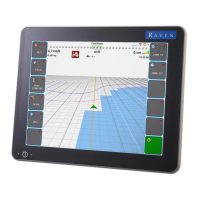
Do you have a question about the Raven viper and is the answer not in the manual?
Instructions for properly routing and securing electrical harnesses to prevent damage and ensure safety.
Instructions for properly routing and securing fluid hoses to prevent damage and ensure safety.
Overview of Raven Operating Software (ROS) features including user profiles, machine configurations, and job profiles.
Details on the ROS platform's design for managing operators, implements, products, and field operations.
Information on ROS interfacing with ISOBUS control systems via virtual terminal and task controller capabilities.
Guidance on obtaining and installing product software and documentation updates from the Raven Applied Technology website.
Instructions for powering up the ROS device and understanding the power status indicator.
Procedure to perform a self-test on the Viper 4+ to diagnose screen display issues.
Steps for initial setup including language, units, and machine configuration.
Description of the ROS home screen and available profile areas or panels.
Details on using the fill-on-screen keyboard for data entry and its features.
Overview of status indicators and navigation through panels like Administrator, Machine, Product, and Job Profile.
Explanation of customizable guidance displays using widget-based tools.
Procedures for selecting, adding, modifying, and removing widgets on screen layouts.
Information on user profiles, PIN security, and profile reporting.
Step-by-step guide for creating, editing, and deleting user profiles.
Details on general user settings, location information, and unit preferences.
Procedures for viewing ROS version, installing updates, and reverting versions.
Viewing firmware information, downloading, and installing CANbus firmware updates.
Procedures for activating special or optional features using permanent or temporary keys.
Accessing information on ROS device hardware, including platform, revision, and lifetime statistics.
Using the File Manager to edit, rename, and manage files and folders on the ROS device.
Procedures for exporting job reports, coverage information, and other field operation files.
Utilities to import various file types from a USB flash drive into the ROS device.
Detailed steps for importing GFF structure, CAN updates, jobs, archives, Rx maps, scout groups, guidance lines, and ISO TaskData.
Overview of machine configurations and automatic detection.
Saving and managing profiles for self-propelled, tractor, and implement types.
Configuring section groups and individual section settings for implements.
Calibrating ROS for GPS antenna position relative to the machine's pivot point.
Displaying and verifying GPS message and correction information.
Configuring compatible Raven receivers, resetting defaults, and selecting differential sources.
Adjusting GPS elevation mask and differential/RTK timeout settings.
Configuring GPS message outputs and accessing receiver information.
Entering authorization codes to unlock additional features for the GPS receiver.
Viewing connected serial devices and performing serial device detection.
Configuring light bar display settings and port communication.
Setting up weather station data logging and GreenSeeker communication settings.
Understanding CANbus systems, detection, and version information.
Managing CANbus nodes, readdressing channels, and resetting nodes to defaults.
Configuring the ROS device for connected speed sensors and calibration values.
Options for providing implement section status using existing or Raven switch boxes.
Setting up control channel assignments and product information for field operations.
Procedures to create, edit, assign, and delete product configurations.
Entering product information for each control channel and setting up product reporting.
Calculating ratios of carrier and mixed ingredients for liquid control systems.
Overview of job profiles, including filtering, editing, and deletion.
Procedures for starting a new job or resuming a previous job operation.
Steps to close an active job and properly shut down the ROS device.
Selecting different views like 3D Guidance, Field Review, Widget View, and Web View.
Managing active alarms, alarm history, and global alarm settings.
Creating, copying, and deleting screen layouts for guidance displays.
Adding, moving, and removing widgets to customize screen layouts.
Description of various guidance widgets like Light Bar, Distance, Nudge, and AB Utilities.
Widgets for Master Switch, Section Status, and On-Screen Switch Box control.
Widgets for Field Area, AutoBoom, Slingshot, ISO, Tally Registers, and Fan Speed.
Options for configuring bin chain setup, primary product, and node management.
Overview of guidance patterns including Straight AB, Pivot, Fixed Contour, and Last Pass.
Procedures for setting AB guidance paths using AB Utilities.
Using nudge features to make incremental adjustments to guidance paths.
Saving features like boundaries, zones, lines, and flags as scout groups.
Creating, loading, deleting, and copying scout groups and features.
Configuring and recording field features using auto or manual point capture.
Viewing aerial map views and field boundaries, including downloading and filtering maps.
Viewing and resetting volume and area tallies for field applications.
Recommended initial speed calibration values for various sensor types.
Procedures for tuning and adjusting speed calibration for radar and wheel drive sensors.
Calculating boom section widths and adjusted rates for spraying applications.